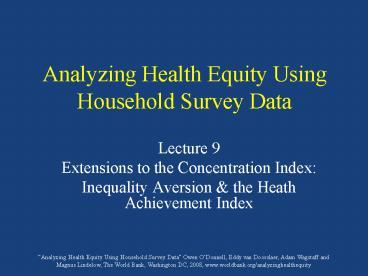Analyzing Health Equity Using Household Survey Data - PowerPoint PPT Presentation
1 / 11
Title:
Analyzing Health Equity Using Household Survey Data
Description:
How can both inequality and the mean be incorporated into one index of health achievement? ... Thus, C is one minus sum of weighted health shares with weights linearly ... – PowerPoint PPT presentation
Number of Views:40
Avg rating:3.0/5.0
Title: Analyzing Health Equity Using Household Survey Data
1
Analyzing Health Equity Using Household Survey
Data
- Lecture 9
- Extensions to the Concentration Index
- Inequality Aversion the Heath Achievement Index
2
Two extensions to the concentration index
- CI incorporates implicit value judgements about
aversion to inequality. It can be extended to
allow different judgements. - CI measures inequality only but the level of
health is also of concern. How can both
inequality and the mean be incorporated into one
index of health achievement?
3
The concentration index is a weighted sum of
individual health shares
where h is health, µ its mean, r fractional rank
- As seen in lecture 8
- This can be written as
- So, in the summation, the health share of each
indv., hi/nµ, is - weighted by 2 (1 - ri)
- Thus, C is one minus sum of weighted health
shares with weights linearly declining from 2
for poorest to 0 for richest individual.
4
An extended concentration index
- Like Yitzhakis (1983) extended Gini , one can
define an extended CI as (Wagstaff, 2003)
- where the inequality aversion parameter v (1)
embodies ethical value judgements about the
extent to which there is aversion to inequality
such that greater weight is placed on the health
share of poorer relative to richer individuals. - v1 ? everyones health is weighted equally
(C(1)0) - v2 ? the linearly declining weighting scheme of
the standard concentration index (C(2)C) - vgt2 ? the weight attached to the health of the
poorest person is ?, and declines non-linearly to
zero for the richest person
5
Alternative weighting schemes for extended
concentration index
6
Estimating the extended CI
By convenient covariance method
Can be calculated for different values of v
By convenient regression method
OLS estimate of ß1 is the extended CI
7
Measures of socioeconomic-related inequality in
malnutrition in Vietnam with different degrees of
inequality aversion
- Negative of height-for-age z-score
- A negative CI indicates more malnutrition among
the poor - As the inequality aversion parameter is raised,
the measured degree of inequality increases
v C(v)
1 0.00
2 -.0771886
3 -.11006521
4 -.12858764
5 -.14068989
8
Taking account of the level and the distribution
of health
- If there is concern for the level of health, and
not only socioeconomic-related inequality in its
distribution, then may want a summary statistic
to reflect mean health in addition to this
inequality. - Might refer to such a measure as an index of
health achievement. - While the extended CI allows for different
degrees of inequality aversion, it places no
weight on the mean of the distribution. For
example v1, C(1)0 irrespective of the value of
the mean. - An index of health achievement can be obtained by
taking a weighted average of levels of health,
rather than of health shares, as follows - That is simply the product of the mean and one
minus the extended CI. - So, for a desirable health variable, increases in
the mean may be traded-off against increases in
pro-rich inequality - For a non-desirable health variable, decreases in
the mean can be traded-off against increases in
its concentration on the poor.
9
The level of malnutrition in Vietnam weighted by
the degree of socioeconomic-related inequality in
its distribution
- Negative of height-for-age z-score
- So a higher value indicates more
inequality-weighted malnutrition - As the inequality aversion parameter is raised,
inequality-weighted malnutrition increases
v C(v) I(v)
1 0.00 2.030
2 -.0771886 2.187
3 -.11006521 2.253
4 -.12858764 2.291
5 -.14068989 2.315
10
Mean and inequality-weighted mean in under-five
mortality
11
Mean and inequality-weighted mean of medically
attended births































